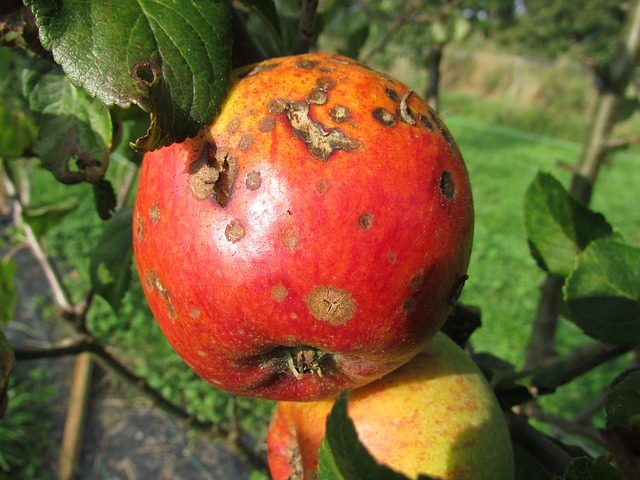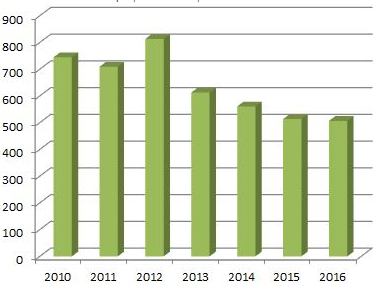The insecticides
industry in China is in a huge transformation these days. Influenced by
increasing production costs, environmental inspections, and rising resistance,
the market is facing serious difficulties, while new opportunities arise. (Originally
published in the May/June issue of Speciality Chemicals).

Source: Pixabay
Since
the peak in 2012, China’s output of insecticides is falling constantly. Hence,
the year 2016 has witnessed another fall. However, the fall in 2016 was the
smallest one in four years, which may indicate an end for the declining
industry trend.
The
output of the pesticides industry in China, on the other hand, was increasing
1% compared to 2016, due to the uprising trend of herbicides and fungicides. As
a fact, the insecticides industry is losing share of the total pesticides
amount in China continuously. Accounting for 31.79% of all pesticides in 2009,
the share declined ongoing to 13.42% in 2017.
Figure 1:China's insecticide output, 2010-2016, 1,000 tonnes

Source: National Bureau
of Statistics of the People’s Republic of China
What’s
more, the production of insecticides is highly concentrated in some areas in
China. As a result, the top three regions are responsible for 72.08% of the
total output. The leading manufacturing region is Jiangsu with a share of
43.77%. The other two main regions for insecticide output are Shandong and
Hubei.
The
past decade has seen the largest structural optimisation in insecticides,
compared with other pesticides. During the 12th Five-year Plan period
(2010-2015), the state attached great importance to optimisation of insecticide
product mix as well as development of new fungicides and herbicides to further
meet demand from crop production.
One
of the biggest problems of pesticides usage in China is the growing problem of
pesticide residue and food safety, resulting of monotonous use in large
amounts. China is using about 1.5 to 2.5 times more pesticides than developed
countries, which raise these concerning issues. What’s more, the damage of
inefficient and overused pesticides is causing losses worth around USD300
billion.
However,
currently the efficiency and quality of insecticides in China is on the rise.
One of the main regions with insecticides manufacturers is Hubei Province in
China. The city Yichang in this province has announced several accomplishments
in the year 2016. These comprise out of insecticides usage on crops, tea and
vegetables reduced by 2%, utilization rate was 39%, green coverage rate of 30%,
and the integrated control and prevention rate was 40%.
Rice Asiatic borers
show high resistance
The
rice Asiatic borer is one of the insects that is showing a surging resistance
to common insecticides in China. Hence, experts predict a heavy strike for 2017
and even the beginning of 2018. According to market intelligence firm CCM, this
trend reveals high opportunities for manufacturers of insecticides in China.
According
to the Nanjing Agriculture University, during the past years, the rice Asiatic
borer has developed resistance against a growing number of insecticides. Monitoring
stations in important provinces started to detect populations highly resistant
to methamidophos, monosultap and triazophos in 1990-2000. What's worse, the
pests developed high resistance to monosultap, triazophos and fipronil later in
2000-2012, and to chlorantraniliprole as well as abamectin after 2017.
The
reasons for the heavy occurrence in 2017 and 2018 can be found in several
factors, including an expanded planting area of hybrid rice, continual rice
planting, excessive fertilising, and improper insecticide application.
However,
the occurring danger is offering huge opportunities for insecticides
manufacturer and trader. Besides innovative products and technology, companies may
also help farmers to use pesticides scientifically and make timely business
adjustments based on field research.
Environmental policies
After
the occurrence of heavy pollution in many Chinese cities 2016, the government
has increased measurements against heavy polluting manufacturers. New standards
were arisen, which many producer failed to meet, leading to production
suspension or even complete cut off.
One
new law with stricter regulations is the Atmospheric
Pollution Prevention and Control Law of the People's Republic of China. The
amended version is considered as the most stringent law for air pollution and
control ever. Specifically, it requires the government to increase financial
supports for air pollution and control and to include it in the national
economic and social development planning.
Furthermore,
great revisions of the Water Pollution
Prevention and Control Law were made compared with the 2008 version. The
new law includes strengthened joint pollution control of rivers that flow
through multiple provinces, including their catchment areas and tributaries as
well as perfected water pollution supervision and control system by connecting
pollutant discharge licensing with total discharge control and discharge
standards.
In
addition to that, manufacturers in China can expect large-scale environmental
inspections by the local authorities. These inspections already begun in the
end of 2016 and will be continued in 2017. These inspections make sure of the
implementation of environmental rectifications.
Affected
the strict regulations, most insecticide manufactures maintained low operating
rates. Reduced output, coupled with increased raw material prices and
environmental costs, pushed up insecticides prices.
Tags: Insecticides, Rice Asiatic borer